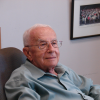
Herman "Harry" Wieder, professor emeritus of Applied Physics at UC- San Diego, passed away peacefully on June 6, 2018 at his residence in La Jolla. A condensed-matter physicist, his interests included basic and applied research in solid-state electronics, quantum wells and superlattice materials and devices.
Harry was born on June 4, 1919, in Bistrita, Romania. He immigrated to the United States in 1937 and became a citizen in 1941. During World War II, Harry served as an Army staff sergeant under General Patton. He was a field radio operator in the 2nd armored division. Patton wanted someone who spoke both French and German (Patton spoke French but not German, while Harry spoke both languages). When Patton was reassigned to England, Harry also worked with the Detached Service for France. He trained the French in Sicily in the use of radios.
After his service in the Army, he used the G.I. Bill to earn a B.S. degree in Applied Physics from UCLA in 1949. He also was awarded an honorary
doctorate in Physics from Colorado State University in 1979, delivering a commencement speech entitled "A Celebration of Creativity."
After World War II and college, Harry got his start as a physicist with the National Bureau of Standards in Washington D.C., from 1949 to 1953, working on ferroelectric materials. He also worked as the head physicist in the Dielectrics and Semiconductor Branch at the Naval Weapons Center in Corona, California from 1953 to 1970. From 1970 to 1973, Harry served as the head of the Semiconductor Physics Branch of the Naval Electronics Laboratory Center, and subsequently as the head of the Electronic Materials Sciences Division of the Naval Ocean Systems Center, San Diego. He joined UC-San Diego as a professor of Applied Physics (ECE) in 1981, achieving emeritus status in 1993. He was also an affiliate professor of physics at Colorado State University.
Harry was most distinguished for his range of interests in his field working in materials, film growth, interface properties, and device concepts. He has influenced the development of electronics, thermoelectrics, and electro- optic technology based on III-V materials. He was a leader in InP technology and was the first to demonstrate high quality InP metal- semiconductor field-effect transistors. He was also one of the first to explore the advantages of ternary and quaternary III-V compounds based on indium for applications in fast switching and electro-optics.
He was a Fellow of the American Physical Society, the Institute of Electrical and Electronic Engineers, and the American Vacuum Society. His awards include the Gold Medal and Medard W. Welch Award from the American Vacuum Society, the Bunshah Prize from the American Vacuum Society, and the Babbage Premium from the British Institute of Electronic and Radio Engineers.
He authored multiple books and papers and was awarded 20 patents.
Throughout his career, and up to his passing, Harry was genuinely engrossed in mentoring younger generations of scientists and engineers, and he always had a burning desire to discuss science at depth.
Quoting from his commencement address at Colorado State University in 1979,
"Creativity is a uniquely personal and individual attribute. Its practice requires self-discipline, artistic and intellectual integrity. It cannot exist without independence of thought and independence of observation. The question of our time—indeed, of all time—is how to solve the problems of society without trampling on the rights of individuals and circumscribing their God-given creative thoughts and actions. Creativity cannot exist without freedom of inquiry, independence of mind, free speech and free association. These freedoms and tolerance of dissent are the hallmarks of a free society committed to the truth even if that truth be bitter at times. This country is and has always been a haven, a refuge, a new home for the uprooted, for creative men and women of all walks of life who chose freedom."
Harry was preceded in death by his wife, Dora, in 2009, and one granddaughter, Lisa, in 2004. He is survived by three children, Mark (and his wife Shauna), Jonathan (and his wife Sheryl), Daniel (and his wife Becky), and one granddaughter, Rachel (and her husband Mark).
